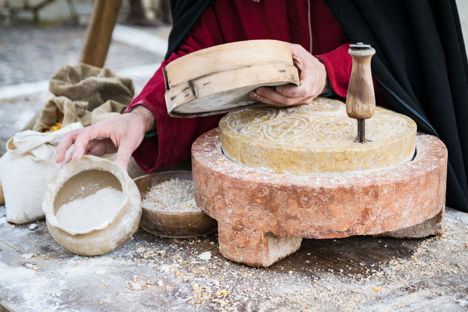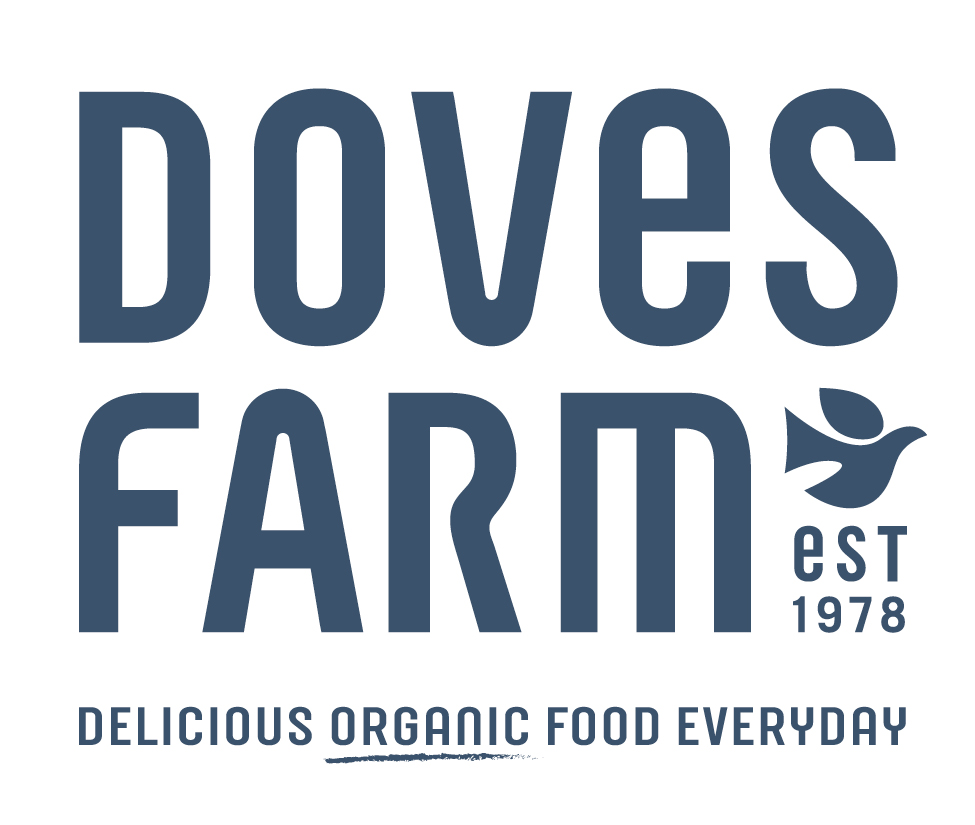
Baking through the ages: a history of flour
From pouring mashed up grains onto hot rocks thousands of years ago to the vast commercial ovens of today, baking has been an integral part of civilisation since the beginning of time. Discover how the simple process of turning wheat into flour has played such an important part in how and what we bake.
Baking through the ages: a history of flour
From pouring mashed up grains onto hot rocks thousands of years ago to the vast commercial ovens of today, baking has been an integral part of civilisation since the beginning of time. Discover how the simple process of turning wheat into flour has played such an important part in how and what we bake.
The vast majority of us pick up a bag of wheat flour without a thought. It’s an ingredient that’s always readily available, is cheap to buy and lasts a very long time in the cupboard. But we don’t really give it the appreciation it deserves – after all, flour is something that has sustained civilisations for millennia, responsible for everything from simple breads to the most decadent cakes and pastries you could think of.
Flour’s importance in the cuisines of Europe, the Americas, northern India and the Middle East is huge – perhaps more than any other ingredient. It’s enjoyed all sorts of statuses: something necessary yet revered in ancient times, a product only the wealthy could afford and a staple for people across the world. Being able to produce flour meant we could bake in different ways, create new things and develop flavours, all of which we take for granted today. Read on for a brief overview of why the (seemingly) simple process of milling wheat grains defined what we baked and how we ate over the centuries.
Ancient times
The world’s oldest oven was discovered in Croatia dating back 6,500 years – but it’s likely mankind was ‘baking’ long before that. It’s thought that even before wheat was being cultivated in the Fertile Crescent (a region in the Middle East) from around 9600 BCE we were collecting wild grass grains, soaking them in water and bashing them with rocks to create a rough paste. This would then be poured onto rocks heated by the sun (and later fires) to gently cook until solid – the earliest and most basic ‘bread’ you can get.
It was the Ancient Egyptians, however, that really started to push baking forward. They would take ancient wheat varieties (such as khorasan, barley and emmer) and pound it with rocks until it was as fine as they could get it – although this would still be much coarser than the flour we know today. Bakers would then knead it with water, shape the dough into loaves and bake them over open fires. They’d sometimes sweeten the bread with honey or fruit juice for the wealthy, or use bread made from barley to create beer. They were also the first civilisation to use wild yeasts to leaven their bread – a technique derived from fermentation in brewing.
In Ancient Rome, baking was big business. Dedicated bakers (known as pastillarium) would create ornate, decadent baked goods for festivals and celebrations. The Greeks created the first dedicated flour mill in the fifth century BCE, which was simple yet much more effective than simply pounding the grains with rocks. The Romans created the first rotary cone mill, however, which could be driven by horses, donkeys or mules, and eventually created watermills that could constantly grind flour on a much larger scale. As with many of the Romans’ inventions, this method soon spread throughout all four corners of the Roman Empire and milling flour became commonplace.
Middle Ages
The following centuries saw watermills (and windmills) spring up all across Europe; farmers would bring their grain to the nearest mill for it to be transformed into flour. Smaller communities would still use small simple hand mills (known as querns), but demand for flour was huge and milling soon became a vital industry. Landowners could build watermills and then impose a tax on all the grain processed by them; a very lucrative business. These mills soon became the most important method of power in medieval Europe – the Domesday Book recorded an incredible 6,000 watermills in England alone during the eleventh century.
The flour created by these mills was much finer than flour created by hand, but it still wasn’t anything like the flour we use today. By simply pulverising the grains into a powder, the outer layers of the grain (known as the germ and bran) weren’t removed or broken down very much, resulting in a dark, gritty flour. This in turn created dense, dark loaves rather than light and airy breads, made with grains such as barley and rye instead of the modern wheat we know today.
Fifteenth to seventeenth centuries
The fifteenth century saw spices such as saffron arrive in Europe, which meant spiced breads soon became a status symbol amongst the wealthy classes. As sugar became less expensive, more and more sweet bakes began to be created. This in turn caused a demand for an even more refined, lighter type of flour, which meant millers would start painstakingly sifting and grinding wheat several times over to remove as much of the germ and bran as possible (a method known as ‘high grinding’), creating a white flour which was better-suited for sweet baking. Of course, only the very wealthy could afford such opulent treats; the lower classes continued to make do with dense, dark loaves.
Towards the eighteenth century, ovens were small and affordable enough to be installed in shops, making a wider range of baked goods massively more accessible to the average person. Sweet cakes and breads started to appear in standard homes (although they were still regarded as a treat for occasions such as Christmas), and more millers were taking the time to create white flour – although it was still much more expensive than regular wholemeal flour.
The Industrial Revolution
In the late eighteenth and early nineteenth centuries, two significant events changed the way flour was created and bread was baked forever. The first was the widespread use of baking powder, which meant bakers no longer had to rely on yeast alone when coming up with new creations. Up until this point, all sweet pastries were dense and doughy, but baking powder meant they could create the sponge-like cakes we know today.
The second was the invention of new roller and steam mills. Until this point, stone mills had worked on the same principles since Roman times – stones turned by water, wind or animals. The first automated flour mill was invented in the US during 1785, and the first one to use steam power was built in 1865 in Hungary. These two inventions were combined to create roller mills, which used a series of metal rollers to break down the wheat and remove the germ and bran completely. The following years saw a huge jump in technology, as new roller mills were constantly developed and improved. Machines dedicated to cleaning and purifying wheat grains were invented and commoditised white flour quickly became available.
With white flour no longer an expensive rarity, more bakers started to delve into the world of intricate pastries. The first French patisserie was established in Paris during the nineteenth century. Commercial yeast became available, making baking much quicker and consistent. Mechanical mixers came along at the beginning of the twentieth century, which meant bakers could create larger quantities of bread and cakes with the help of machines. Baked goods of all kinds became commonplace, and flour became the pure uniform powder we know it as today.
Modern times
Today, milling flour is an industrial process that’s entirely automated. The wheat is cleaned of any impurities, before being poured into a roller mill which breaks the grain down and sieves out the germ and bran a number of times until only pure white flour is left. For wholemeal flours, the process is usually the same – the germ and bran are simply reintroduced after milling. It’s done on such a massive scale that flour has become constantly available, very affordable and comes in different strengths for various types of baking.
With mass-produced flour came mass-produced baking – while it meant bread and cakes could be created on a huge scale, in recent years there’s been a backlash to the additives needed to do this. The Chorleywood breadmaking process was invented in the 1960s and quickly became the most common way of producing bread thanks to its ability to increase shelf life, but it sacrificed depth of flavour in the process. The ‘Real Bread Movement’ was set up to counteract this, and champions making bread the old-fashioned way.
As you can see, flour has gone from being an ingredient that took an immense amount of work and time to create into a commodity that we take for granted. Our baking has changed with it, going from loaves of dark, dense bread baked purely for subsistence to the saffron-spiced buns of the fifteenth century and eventually the white loaves we see everywhere today. So the next time you pick up a bag of flour during your weekly shop, give a thought to just how important this humble ingredient has been over the centuries. It’s only in the past few hundred years that it’s been truly refined, but it has been an integral part of civilisation since the dawn of time.


